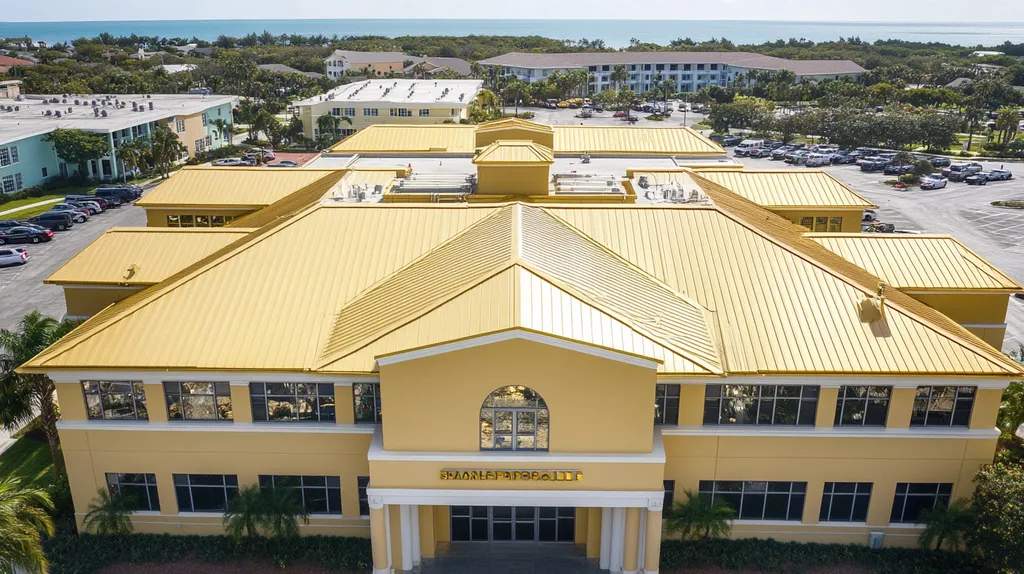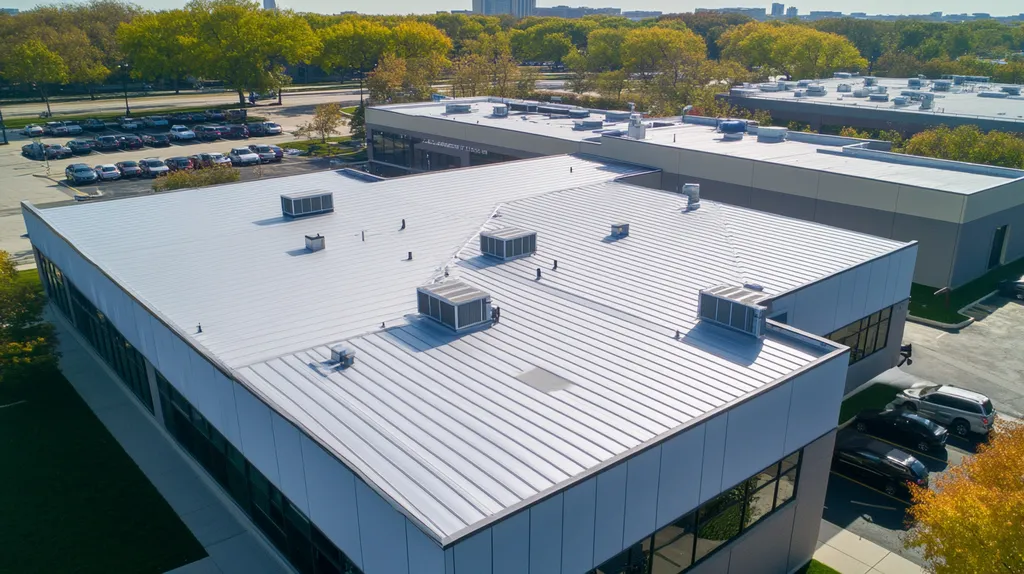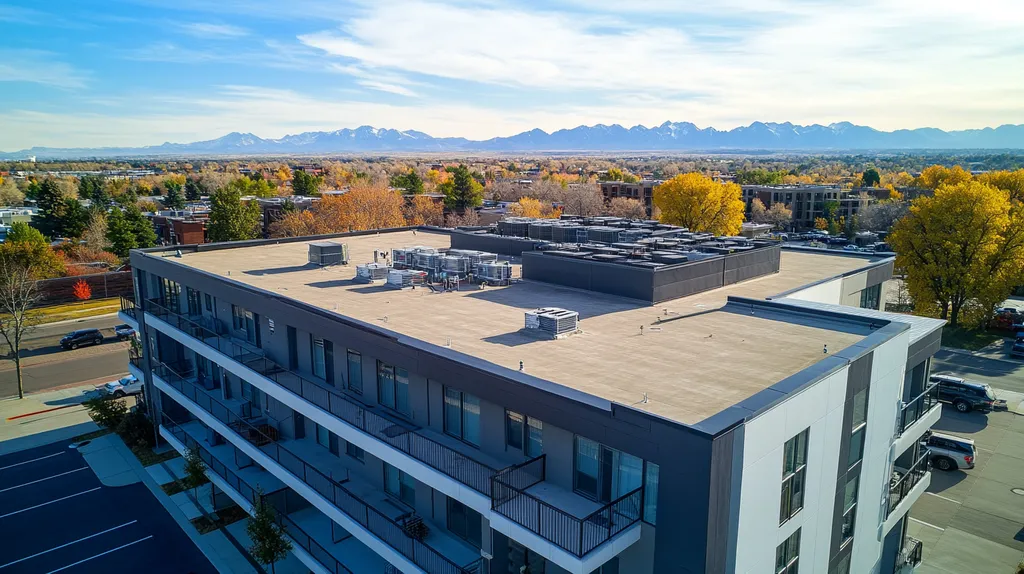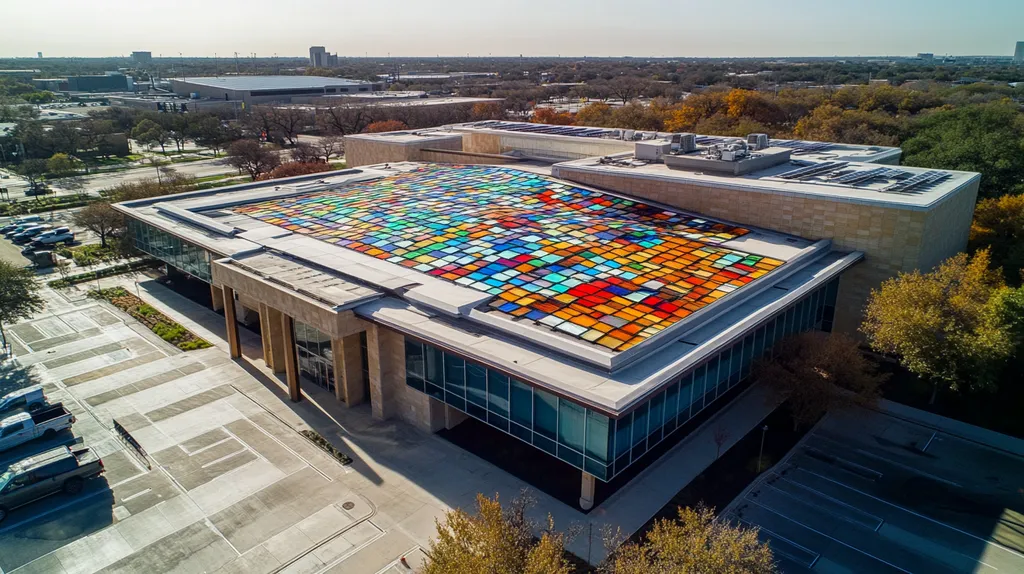Welcome to today’s Battle Royale featuring two roofing heavyweights: “PVC” in the east corner versus “TPO” in the west!
Tonight’s showdown pits these contenders against each other across six punishing rounds designed to test every aspect of their performance for Industrial Roof Replacement.
At stake? Millions in potential costs, decades of building protection, and the critical performance demands of modern commercial and industrial facilities.
Our professional judging panel will evaluate each round on technical merit, real-world performance, and value delivery. After all six rounds, we’ll declare our ultimate champion.
Ladies and gentlemen, facility managers and building owners… it’s time to rumble!
ROUND 1: INITIAL COSTS & INSTALLATION
When an industrial roof fails, the consequences can be catastrophic – from inventory damage to production delays that cost thousands per hour. Recent industry data shows that poorly timed roof replacements lead to 40% higher emergency repair costs and significant business disruptions. Understanding the initial investment and installation requirements of PVC versus TPO roofing systems is crucial for making a decision that protects both your facility and bottom line.
Material Expenses
The upfront cost of roofing materials represents a significant portion of any industrial roof replacement budget. PVC roofing materials typically command premium prices, ranging from $7.50 to $12.00 per square foot for commercial-grade applications.
TPO presents a more budget-friendly alternative, with material costs typically falling between $4.00 and $7.00 per square foot. This lower entry point makes TPO an attractive option for projects with tight initial budgets.
However, PVC’s superior chemical resistance and proven longevity often justify its higher price point, potentially offering better value over the complete lifecycle of the roof system.
For material expenses, TPO takes the “ADVANTAGE” due to its significantly lower upfront costs.
Installation Complexity
The complexity of installation directly impacts both project timeline and long-term performance. PVC roofing requires specialized welding equipment and highly trained installers to ensure proper seam fusion and detail work around penetrations.
TPO installation, while still requiring professional expertise, generally involves fewer technical challenges. The material is lighter and more flexible, making it easier to maneuver and position during installation.
However, PVC’s more demanding installation process results in stronger seams and better detail work, reducing the risk of future leaks and failures.
In installation complexity, PVC claims the “ADVANTAGE” as its more rigorous process leads to superior long-term performance.
Project Timeline
Time is money in industrial facilities, where every day of roof work can impact operations. TPO installations typically move faster due to the material’s lighter weight and simpler welding requirements, often completing 20-30% quicker than comparable PVC projects.
PVC installations demand more time for proper heat welding and detail work. While this extends the project duration, it helps ensure a more reliable installation that minimizes future disruptions for repairs.
The speed advantage of TPO can significantly reduce facility disruption and allow for quicker return to normal operations.
For project timeline considerations, TPO earns the “ADVANTAGE” with its faster installation process.
ROUND 1 RESULTS: TIE
ROUND 2: DURABILITY & LIFESPAN
When industrial roofs fail prematurely, the consequences ripple throughout the entire facility. Recent data shows that 75% of commercial roof replacements occur years before they should, primarily due to poor material selection and inadequate maintenance planning. Understanding the durability differences between PVC and TPO roofing can mean the difference between a 20-year worry-free installation and costly emergency repairs.
Understanding Longevity
A roof’s expected lifespan directly impacts your facility’s long-term operational costs. PVC roofing systems consistently demonstrate superior longevity, with properly installed membranes lasting 25-30 years in demanding industrial environments.
TPO roofing typically provides 15-20 years of service life under optimal conditions. While newer TPO formulations show improved durability, they still haven’t matched PVC’s proven track record in harsh industrial settings.
The dramatic difference in service life makes PVC the clear ADVANTAGE winner for longevity considerations.
Chemical and Environmental Resistance
Industrial environments often expose roofing materials to harsh chemicals, UV radiation, and extreme temperature fluctuations. PVC membranes excel in these conditions, maintaining their integrity even when exposed to industrial chemicals, oils, and animal fats.
TPO offers good resistance to common environmental factors but can show vulnerability when exposed to certain industrial chemicals and sustained high temperatures. Some facilities have reported premature membrane degradation in areas with heavy chemical exposure.
For chemical and environmental resistance, PVC demonstrates the ADVANTAGE.
Impact and Puncture Resistance
Daily wear and tear from foot traffic, equipment maintenance, and falling debris can compromise roofing integrity. PVC membranes offer superior thickness consistency and reinforcement, making them highly resistant to punctures and tears.
While TPO membranes provide adequate impact resistance for many applications, they typically show more vulnerability to punctures and mechanical damage. This can lead to more frequent repairs and maintenance interventions.
In terms of impact and puncture resistance, PVC claims another clear ADVANTAGE.
ROUND 2 WINNER: PVC Roofing
ROUND 3: PERFORMANCE FACTORS
The performance of an industrial roof directly impacts facility operations, worker safety, and the bottom line. Recent facility audits reveal that poor-performing roofs lead to a 45% increase in energy costs and can result in inventory losses exceeding $100,000 from a single leak event. Understanding how PVC and TPO perform across key metrics is essential for making an investment that protects your facility’s future.
Weather Resistance
In industrial settings, roofing materials must withstand everything from intense UV exposure to chemical fallout and extreme temperature swings. PVC roofing demonstrates exceptional resistance to weathering, maintaining its protective properties even after decades of exposure to harsh conditions.
PVC’s molecular structure creates a naturally UV-resistant barrier that prevents degradation and brittleness. This chemical stability means PVC roofs typically maintain their protective properties for 25-30 years without significant deterioration.
TPO roofing offers good initial weather resistance but can show signs of accelerated aging in harsh industrial environments. While newer TPO formulations have improved, they still haven’t matched PVC’s proven track record against sustained environmental assault.
For weather resistance, PVC claims the ADVANTAGE with its superior long-term performance against environmental stressors.
Thermal Performance
Energy efficiency has become a critical factor in industrial roofing, with heating and cooling costs representing up to 30% of facility operating expenses. PVC roofing systems offer outstanding thermal performance, with highly reflective surfaces that significantly reduce heat absorption.
Advanced PVC formulations maintain their reflective properties throughout their lifespan, helping facilities maintain consistent energy efficiency. The material’s dimensional stability also prevents thermal cycling damage that can compromise insulation effectiveness.
TPO provides good initial thermal performance but may lose reflectivity faster than PVC. Some facilities report increased cooling costs as TPO ages and its surface degrades, particularly in high-temperature environments.
In thermal performance, PVC earns the ADVANTAGE due to its superior long-term reflective properties.
Seam Strength
The integrity of roofing seams often determines system longevity, as these joints are common failure points in industrial applications. PVC creates extremely strong, reliable seams through heat welding, forming molecular bonds that are actually stronger than the membrane itself.
PVC seams maintain their strength even under extreme stress, with properly welded joints showing virtually no degradation over time. This reliability is crucial for industrial facilities where roof failures can halt production.
TPO also utilizes heat-welded seams but can be more sensitive to welding conditions and technique. Some facilities report seam failures within the first decade, particularly in areas subject to repeated stress or ponding water.
For seam strength, PVC demonstrates the ADVANTAGE through superior bond strength and reliability.
ROUND 3 WINNER: PVC Roofing
ROUND 4: MAINTENANCE REQUIREMENTS
Poor maintenance practices cost industrial facilities millions annually in emergency repairs and premature replacements. Studies show that 78% of catastrophic roof failures stem from neglected maintenance issues that could have been prevented. Understanding the maintenance demands of PVC versus TPO roofing systems is crucial for protecting your facility investment and avoiding costly disruptions.
Routine Inspection Requirements
PVC roofing systems demonstrate exceptional durability between inspections, typically requiring only bi-annual professional assessments in most industrial environments. The material’s inherent chemical stability and superior seam strength mean fewer unexpected issues arise between scheduled maintenance visits.
The robust nature of PVC membranes allows maintenance teams to focus on specific areas of concern rather than conducting comprehensive inspections every quarter. This targeted approach significantly reduces the maintenance burden on facility staff and budgets.
TPO systems generally require more frequent inspections, with quarterly checks recommended to monitor seam integrity and surface degradation. The material’s higher sensitivity to environmental stressors necessitates closer monitoring to prevent developing issues.
For routine inspection requirements, PVC claims the ADVANTAGE due to its reduced inspection frequency needs.
Repair Complexity
When repairs become necessary, PVC membranes offer significant advantages through their heat-weldable nature. Even after years of service, PVC maintains its weldability, allowing for seamless repairs that restore the membrane to like-new condition.
Repair crews can typically complete PVC fixes more quickly due to the material’s consistent welding characteristics. This translates to shorter facility disruptions and lower repair labor costs.
TPO repairs can present more challenges, particularly as the membrane ages. The material may require more extensive surface preparation and precise welding conditions to achieve reliable repairs.
For repair complexity, PVC demonstrates the ADVANTAGE through its superior repair characteristics.
Long-term Maintenance Costs
The true cost of maintenance extends far beyond routine inspections to include repairs, cleaning, and preventive treatments. PVC roofing systems typically show lower long-term maintenance costs due to their inherent durability and resistance to environmental damage.
Most PVC installations maintain their performance characteristics with minimal intervention, requiring only basic cleaning and occasional seam inspection. This predictability helps facilities manage maintenance budgets more effectively.
TPO systems often incur higher cumulative maintenance costs due to more frequent cleaning requirements and a higher likelihood of requiring repairs. The material’s sensitivity to certain chemicals and UV exposure can necessitate additional protective treatments over time.
In terms of long-term maintenance costs, PVC earns the ADVANTAGE through reduced lifetime maintenance expenses.
ROUND 4 WINNER: PVC Roofing
ROUND 5: SUSTAINABILITY CREDENTIALS
Today’s industrial facilities face mounting pressure to reduce their environmental impact while maintaining operational efficiency. Recent data shows facilities with sustainable roofing systems reduce energy costs by up to 35% and significantly lower their carbon footprint. Understanding how PVC and TPO roofing materials align with sustainability goals has become crucial for facility managers making long-term infrastructure decisions.
Environmental Impact
The manufacturing and disposal processes of roofing materials directly impact a facility’s environmental footprint. PVC production requires significant energy input and generates chlorine-based byproducts, though modern manufacturing has reduced these impacts considerably.
Many PVC roofing materials now incorporate recycled content and can be reprocessed at the end of their service life. However, the material’s chemical composition still presents environmental challenges during production and disposal.
TPO manufacturing requires less energy and produces fewer harmful byproducts. The material is also fully recyclable and often contains a higher percentage of recycled content in its initial production.
For environmental impact considerations, TPO claims the ADVANTAGE due to its cleaner manufacturing process and superior recyclability.
Energy Performance
Roofing systems play a crucial role in facility energy efficiency, particularly in climate-controlled industrial spaces. Both PVC and TPO offer excellent initial solar reflectivity, helping reduce cooling loads during summer months.
PVC membranes maintain their reflective properties longer, requiring less frequent cleaning or recoating to preserve their energy-saving benefits. Their superior chemical resistance also prevents degradation that could compromise thermal performance.
TPO’s initial reflectivity matches or exceeds PVC but may degrade faster in harsh industrial environments. However, TPO’s lower thermal conductivity provides better insulation value throughout the year.
Energy performance results in a TIE, as both materials offer distinct but valuable energy-saving benefits.
Lifecycle Assessment
The total environmental impact of roofing materials extends from manufacturing through disposal. PVC’s longer service life – often exceeding 25 years – means fewer replacement cycles and reduced material consumption over time.
The durability of PVC reduces maintenance requirements and associated resource consumption. Its resistance to chemical exposure also eliminates the need for protective coatings that could impact environmental performance.
TPO’s shorter lifecycle increases material turnover but benefits from easier recycling and lower-impact manufacturing. Its simpler chemical composition allows for more straightforward reprocessing into new materials.
For lifecycle assessment, PVC earns the ADVANTAGE through superior longevity and reduced replacement frequency.
ROUND 5 RESULTS: TIE
ROUND 6: SPECIALIZED APPLICATIONS
Industrial facilities face unique roofing challenges that can make or break operational success. Recent facility audits reveal that 65% of premature roof failures occur in specialized applications where the wrong material choice led to catastrophic system breakdown. Understanding how PVC and TPO perform in demanding industrial environments is crucial for protecting both assets and operations.
Material Versatility
Industrial environments demand roofing materials capable of handling extreme conditions, from chemical exposure to heavy equipment loads. PVC demonstrates exceptional versatility across challenging applications, particularly in facilities dealing with harsh chemicals, oils, and industrial processes.
PVC’s molecular structure allows it to maintain integrity even when exposed to aggressive industrial chemicals and high-temperature processes. This makes it ideal for manufacturing facilities, chemical storage areas, and food processing plants.
TPO offers good general-purpose performance but shows limitations in highly specialized applications. While effective in standard industrial settings, it can struggle when exposed to certain chemicals and extreme temperature fluctuations.
For material versatility, PVC claims the ADVANTAGE through its superior chemical resistance and adaptability.
Installation Flexibility
Complex industrial roofing projects often require creative solutions around equipment, vents, and unusual penetrations. PVC’s superior workability allows installers to create custom solutions for challenging details, ensuring watertight seals even in difficult applications.
The material’s consistent welding characteristics make it possible to form reliable connections even in tight spaces or around irregular shapes. This flexibility proves crucial when dealing with industrial equipment penetrations and unique architectural features.
TPO installation offers less flexibility when dealing with complex details. While adequate for standard applications, it can present challenges when precise custom fitting is required around specialized equipment or unusual roof features.
In installation flexibility, PVC earns the ADVANTAGE through superior workability and detail adaptation.
Performance Specialization
Different industrial applications demand specific performance characteristics from their roofing systems. PVC excels in environments requiring chemical resistance, such as pharmaceutical manufacturing or chemical processing facilities.
The material’s proven track record in specialized applications includes resistance to animal fats (crucial for food processing), industrial solvents, and acid rain. This specialized performance often makes it the only viable option for certain industrial applications.
TPO performs adequately in general industrial settings but lacks the specialized resistance properties needed for more demanding applications. Its performance limitations become apparent in facilities requiring specific chemical or temperature resistance.
For performance specialization, PVC demonstrates the ADVANTAGE through superior specialized resistance properties.
ROUND 6 WINNER: PVC Roofing
AND THE WINNER IS…
After six grueling rounds of technical evaluation, we have our verdict…
Ladies and gentlemen, with four decisive round victories, the undisputed champion of industrial roofing supremacy is PVC ROOFING!
PVC dominated the competition through superior durability, unmatched chemical resistance, and exceptional long-term performance. Its victories in specialized applications, maintenance requirements, and overall performance factors showcase why it remains the heavyweight champion for demanding industrial environments.
But don’t count TPO out entirely! This scrappy contender proved its worth with competitive initial costs and faster installation times. For facilities with tight budgets and less demanding environmental conditions, TPO can still deliver a solid performance.
Remember, folks: Every building tells its own story. Local climate conditions, facility operations, and specific property requirements can all impact roofing performance. While PVC claims tonight’s title, your facility’s unique characteristics might favor a different champion. Always consult with qualified roofing professionals who can evaluate your specific situation before making your final decision.
In the high-stakes world of industrial roofing, victory doesn’t just come from picking the strongest contender – it comes from choosing the right fighter for YOUR corner!
FREQUENTLY ASKED QUESTIONS
Q. What are the initial costs for a commercial roof replacement?
A. The initial costs vary significantly between PVC and TPO roofing. PVC materials are generally more expensive, ranging from $7.50 to $12.00 per square foot, while TPO is more budget-friendly at $4.00 to $7.00 per square foot. Choosing the right material involves weighing initial costs against long-term value and performance.
Q. How long can an industrial roof last?
A. The lifespan of an industrial roof varies between materials. PVC roofing often lasts 25-30 years, making it highly durable. In contrast, TPO typically provides a service life of around 15-20 years. Choosing a material with a long track record for durability can prevent premature replacement and costly repairs.
Q. Which roofing material is better for weather protection?
A. For weather protection, PVC roofing demonstrates exceptional resistance to environmental factors. It can withstand UV exposure, chemicals, and extreme temperature fluctuations without significant degradation. TPO provides good initial weather resistance but may age faster in harsh conditions, making PVC the preferred choice for long-term durability.
Q. How often should I inspect my commercial roof?
A. The inspection frequency for your commercial roof depends on the material. PVC roofs typically require bi-annual inspections, while TPO membranes need closer monitoring with quarterly checks. Regular maintenance is crucial to extend the lifespan of your roof and catch potential issues early.
Q. Which roofing material has lower long-term maintenance costs?
A. PVC roofing generally incurs lower long-term maintenance costs due to its durability. It requires fewer repairs and less frequent inspections. TPO, while initially cost-effective, can lead to higher cumulative maintenance costs over time due to its sensitivity to environmental stressors.
Q. How do PVC and TPO compare in specialized applications?
A. PVC excels in specialized applications requiring chemical resistance and durability, making it ideal for demanding environments. TPO’s general-purpose performance may suffice in standard settings but struggles under extreme conditions. For critical applications, PVC’s versatility is often the better choice to prevent costly failures.
Q. Which roofing material is more sustainable?
A. TPO is considered more sustainable due to its lower energy-intensive manufacturing process and higher recyclability. PVC has made strides by incorporating recycled content but still poses environmental concerns during production. When evaluating sustainability, both materials have merits that need to be carefully assessed.











